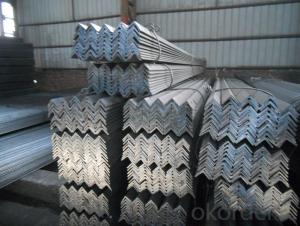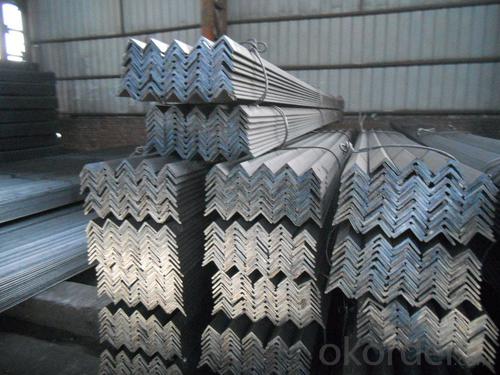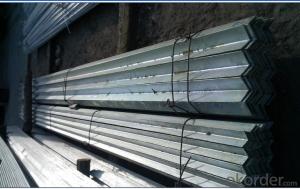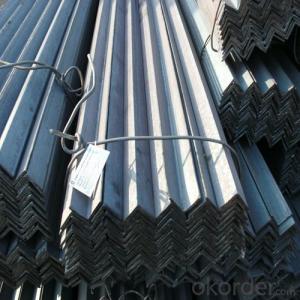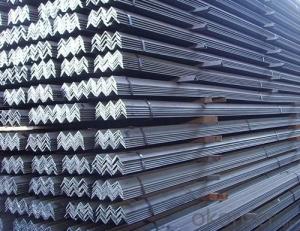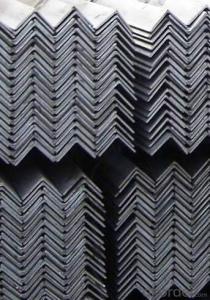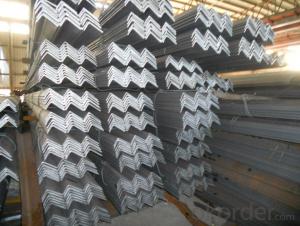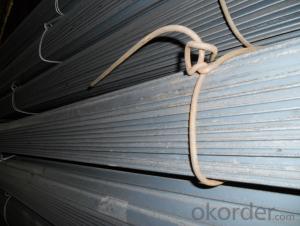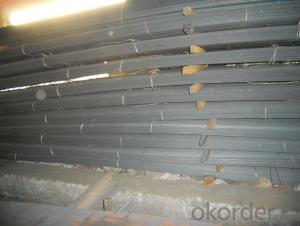Hot Rolled Equal Angle Steel of Low Carbon for Towers
- Loading Port:
- Shanghai
- Payment Terms:
- TT OR LC
- Min Order Qty:
- 25 m.t.
- Supply Capability:
- 200000 m.t./month
OKorder Service Pledge
OKorder Financial Service
You Might Also Like
Specification
Product Description:
OKorder is offering Hot Rolled Equal Angle Steel of Low Carbon for Towers at great prices with worldwide shipping. Our supplier is a world-class manufacturer of steel, with our products utilized the world over. OKorder annually supplies products to European, North American and Asian markets. We provide quotations within 24 hours of receiving an inquiry and guarantee competitive prices.
Product Applications:
Hot Rolled Equal Angle Steel of Low Carbon for Towers are ideal for structural applications and are widely used in the construction of buildings and bridges, and the manufacturing, petrochemical, and transportation industries.
Product Advantages:
OKorder's Hot Rolled Equal Angle Steel of Low Carbon for Towers are durable, strong, and resist corrosion.
Main Product Features:
· Premium quality
· Prompt delivery & seaworthy packing (30 days after receiving deposit)
· Corrosion resistance
· Can be recycled and reused
· Mill test certification
· Professional Service
· Competitive pricing
Product Specifications:
Specifications of Hot Rolled Equal Angle Steel of Low Carbon for Towers
1. Invoicing on theoretical weight or actual weight as customer request.
2. Length: 6m, 9m, 12m.
3. Sizes:
Size(mm) | Mass(Kg/m) | Size(mm) | Mass(Kg/m) |
50*50*4 | 3.059 | 63*63*5 | 4.822 |
50*50*5 | 3.77 | 63*63*6 | 5.721 |
50*50*6 | 4.465 |
Alloy No | Grade | Element (%) | |||||
C | Mn | S | P | Si | |||
Q235 | B | 0.12—0.20 | 0.3—0.7 | ≤0.045 | ≤0.045 | ≤0.3 | |
Alloy No | Grade | Yielding strength point( Mpa) | |||||
Thickness (mm) | |||||||
≤16 | >16--40 | >40--60 | >60--100 | ||||
≥ | |||||||
Q235 | B | 235 | 225 | 215 | 205 | ||
Alloy No | Grade | Tensile strength (Mpa) | Elongation after fracture (%) | ||||
Thickness (mm) | |||||||
≤16 | >16--40 | >40--60 | >60--100 | ||||
≥ | |||||||
Q235 | B | 375--500 | 26 | 25 | 24 | 23 | |
Packaging & Delivery of Hot Rolled Equal Angle Steel of Low Carbon for Towers
1. Packing: it is nude packed in bundles by steel wire rod
2. Bundle weight: not more than 3.5MT for bulk vessel; less than 3 MT for container load
3. Marks:
Color marking: There will be color marking on both end of the bundle for the cargo delivered by bulk vessel. That makes it easily to distinguish at the destination port.
Tag mark: there will be tag mark tied up on the bundles. The information usually including supplier logo and name, product name, made in China, shipping marks and other information request by the customer.
If loading by container the marking is not needed, but we will prepare it as customer request.
4. Transportation: the goods are delivered by truck from mill to loading port, the maximum quantity can be loaded is around 40MTs by each truck. If the order quantity cannot reach the full truck loaded, the transportation cost per ton will be little higher than full load.
5. Delivered by container or bulk vessel
FAQ:
Q1: Why buy Hot Rolled Equal Angle Steel of Low Carbon for Towers from OKorder.com?
A1: All products offered byOKorder.com are carefully selected from China's most reliable manufacturing enterprises. Through its ISO certifications, OKorder.com adheres to the highest standards and a commitment to supply chain safety and customer satisfaction.
Q2: How do we guarantee the quality of our products?
A2: We have established an advanced quality management system which conducts strict quality tests at every step, from raw materials to the final product. At the same time, we provide extensive follow-up service assurances as required.
Q3: How soon can we receive the product after purchase?
A3: Within three days of placing an order, we will begin production. The specific shipping date is dependent upon international and government factors, but is typically 7 to 10 workdays.
Images:
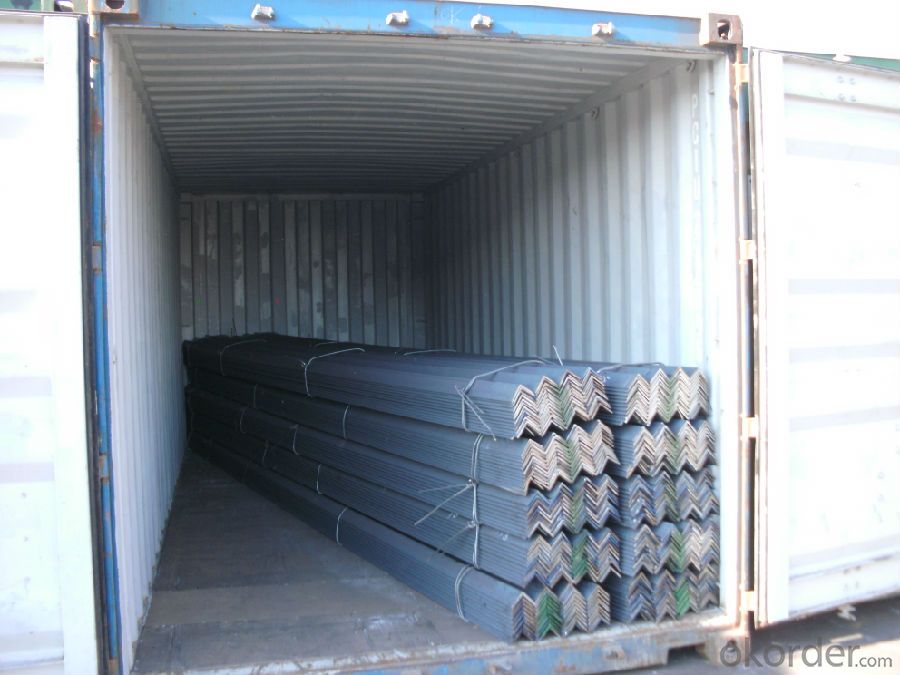

- Q: Can steel angles be used in the construction of staircases?
- Yes, steel angles can be used in the construction of staircases. Steel angles provide structural support and stability, making them a suitable choice for building staircases.
- Q: How do you clean steel angles?
- To clean steel angles, you can follow a few simple steps. First, gather the necessary supplies: mild detergent or soap, warm water, a soft cloth or sponge, and a non-abrasive brush or scrub pad. Begin by filling a bucket or sink with warm water and adding a small amount of mild detergent or soap. Gently mix the solution until it forms a slight foam. Wet the cloth or sponge with the soapy water and gently scrub the steel angles, ensuring that all areas are covered and any dirt or grime is removed. For tougher stains or stubborn debris, use the non-abrasive brush or scrub pad to gently scrub the surface. Avoid using abrasive cleaners or steel wool, as they can scratch or damage the steel surface. It is also important to steer clear of acidic or corrosive cleaners, as they can cause discoloration or rusting of the steel. After thoroughly cleaning the steel angles, rinse them with clean water to eliminate any remaining soap residue. Use a clean, soft cloth to dry the angles and prevent water spots or streaks from forming. Regular cleaning and maintenance are crucial for keeping steel angles in their best condition and preventing corrosive damage. By following these steps, you can effectively clean steel angles and maintain their appearance for years to come.
- Q: Are steel angles resistant to chemical corrosion?
- Yes, steel angles are resistant to chemical corrosion due to the protective oxide layer that forms on their surface, which helps prevent chemical reactions and corrosion.
- Q: How do you connect steel angles to other structural members?
- Steel angles can be connected to other structural members through various methods, such as welding, bolting, or using connector plates.
- Q: Can steel angles be drilled or cut?
- Yes, steel angles can be drilled or cut. Steel angles are a versatile structural material that is commonly used in various construction and manufacturing projects. They can be easily drilled to create holes for bolts, screws, or other fasteners. Additionally, steel angles can be cut to specific lengths or shapes using tools such as saws, plasma cutters, or shears. The ability to drill or cut steel angles makes them highly adaptable and suitable for a wide range of applications.
- Q: Can steel angles be used as supports for mechanical or HVAC ducts?
- Yes, steel angles can be used as supports for mechanical or HVAC ducts. Steel angles provide a strong and durable framework to securely hold and provide stability to the ductwork.
- Q: What are the common methods of surface preparation for steel angles?
- Common methods of surface preparation for steel angles include abrasive blasting, such as sandblasting or shot blasting, to remove rust, scale, and contaminants from the surface. Chemical cleaning can also be used to remove oils, greases, and other organic materials. Additionally, mechanical cleaning methods like wire brushing or grinding can be employed to smooth out rough surfaces and remove any remaining debris.
- Q: How do you calculate the critical buckling load for a steel angle?
- In order to determine the critical buckling load for a steel angle, one must take into consideration the properties of the angle section and how it interacts with the applied loads. The critical buckling load refers to the maximum load that the angle section can handle before it buckles or fails in a lateral-torsional manner. The initial step involves calculating the section properties of the steel angle, such as its moment of inertia (I) and section modulus (Z). These properties can be obtained either from standard structural design tables or through mathematical calculations. Subsequently, the effective length factor (K) for the angle section needs to be considered. This factor accounts for the angle's end conditions and how it is restrained against buckling. Different end conditions have varying values for K, which can be determined from design codes or engineering references. Once the section properties and effective length factor have been determined, the critical buckling load can be calculated using Euler's buckling equation: Pcr = (π^2 * E * I) / (K * L^2) Here, Pcr represents the critical buckling load, π is a mathematical constant (approximately 3.14159), E denotes the modulus of elasticity of the steel, I signifies the moment of inertia of the angle section, K represents the effective length factor, and L stands for the unsupported length of the angle section. By substituting the appropriate values for E, I, K, and L into the equation, one can calculate the critical buckling load for the steel angle. It is crucial to note that the critical buckling load is a theoretical value and should be compared to the actual applied loads to ensure the safety of the angle section under the given conditions.
- Q: What are the different types of connections used for steel angles in residential applications?
- In residential applications, steel angles can be connected using various types of connections. Some commonly used ones are: 1. Welded connections: The angle is welded to nearby structural members like beams or columns. Welded connections offer great strength and rigidity, making them ideal for residential purposes. 2. Bolted connections: Bolts and nuts are used to secure the steel angle to adjacent members. This type of connection is suitable when the angle needs to be easily removable or adjustable. Bolted connections are less rigid than welded ones but still provide sufficient strength for residential use. 3. Clip connections: Clips or brackets are attached to the angle, which is then fastened to wood or non-steel materials using screws or nails. Clip connections are commonly used in residential framing. 4. Gusset plate connections: When two steel angles need to be joined, a flat steel plate known as a gusset plate is welded or bolted to the angles for added support and rigidity. This connection type is often found in residential roof trusses and other structural applications. 5. Cleat connections: A steel plate called a cleat is either bolted or welded to the steel angle and the adjacent member. Cleat connections are frequently used when the angle needs to be attached to a horizontal member like a floor or roof joist. These examples showcase the different connection types employed for steel angles in residential applications. The choice of connection will depend on factors such as structural requirements, ease of installation, and the materials being connected.
- Q: How are steel angles welded or joined together?
- Different welding techniques are commonly employed to weld or join steel angles. The prevalent method involves the use of arc welding, which encompasses shielded metal arc welding (SMAW), gas metal arc welding (GMAW), and flux-cored arc welding (FCAW). In shielded metal arc welding, an electric arc is established between a coated electrode and the steel angle. This causes the metals to melt and creates a weld joint. Gas metal arc welding, on the other hand, utilizes a continuous wire electrode and a shielding gas like argon or a combination of argon and carbon dioxide. This shielding gas safeguards the weld from atmospheric impurities. Flux-cored arc welding employs a hollow wire electrode containing flux. This generates a shielding gas and slag that protect the weld. Resistance welding is another technique used for joining steel angles. It involves the application of pressure and the passage of an electric current through the joint area. This generates heat, resulting in a weld. Spot welding and seam welding are commonly employed resistance welding methods for steel angles. Furthermore, steel angles can be joined using stud welding. This process entails placing a threaded or unthreaded stud against the steel angle and utilizing an arc welding process to fuse the stud to the angle. It should be noted that the choice of welding or joining method for steel angles depends on factors such as the thickness and type of steel, the desired joint strength, and the specific requirements of the application.
Send your message to us
Hot Rolled Equal Angle Steel of Low Carbon for Towers
- Loading Port:
- Shanghai
- Payment Terms:
- TT OR LC
- Min Order Qty:
- 25 m.t.
- Supply Capability:
- 200000 m.t./month
OKorder Service Pledge
OKorder Financial Service
Similar products
Hot products
Hot Searches
Related keywords
